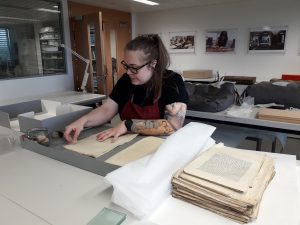My name is Claire and I am the first intern to work with Nicole on the Session Papers Project. I am due to graduate with a master’s degree in paper conservation this year, but I am starting this internship to broaden my knowledge of book conservation. Methods and skills within conservation tend to overlap, and this is especially true with books and paper. My role within this pilot project is to assist in the conservation of 300 books. Conservation treatments include structural repairs, consolidation, and board reattachment. The volumes need to be in a good enough condition to withstand digitisation and further handling following the project.

Claire working in the conservation studio
The books vary in condition, however, all treatments start the same – with surface cleaning! Some of the volumes in the collection were particularly grubby, so all cleaning took place in the fume cupboard, wearing gloves and a dust mask. The edges of the pages were cleaned with a museum vacuum to remove any surface dirt and mould spores. The pages of some volumes were uneven in size – an example of this can be seen below. This has also caused significant structural damage to the edges; the paper has distorted and surface dirt has penetrated further into the text block.

Surface cleaning the edges of the text block to remove any mould or dirt.

Edge of the text block. Different paper sizes have caused structural damage.
Although a lot of the surface dirt was ingrained, the removal of the loose dirt will aid handling of the books during digitisation, and prevent transfer of dirt to other items. It is also an important first step, so that other treatments such as tear repair can take place. The visual improvements made by surface cleaning have been incredibly satisfying! Below is a photograph before and after cleaning the top of the volume with the museum vacuum. After using the vacuum, the book is opened and cleaned internally with smoke sponge.

Text block edge, before cleaning.

Text block edge, after cleaning.
Whilst cleaning the pages, I also look out for any tears or losses in the paper. They are repaired with a lightweight Japanese tissue paper and wheat starch paste. The Japanese tissue is strong enough to provide structural reinforcement, but light enough so that it does not disrupt the legibility of the text. In most cases, the worn edges of the pages need general reinforcement, so I chose to apply a strip of Japanese paper along the entirety of the outer edge and trim it upon drying. This improved the tensile strength of the paper and should prevent any existing tears getting worse.

Reinforcing the edge of the page using Japanese paper.
I am only a few weeks in to this internship, but already my skills and practice in book conservation has improved significantly. To some, the work may seem repetitive, but it is incredibly rewarding to work on a project such as this and to see your hard work come to fruition. I have quite a few more books to do before my time is up, however, I am looking forward to the next few weeks and meeting my targets!
